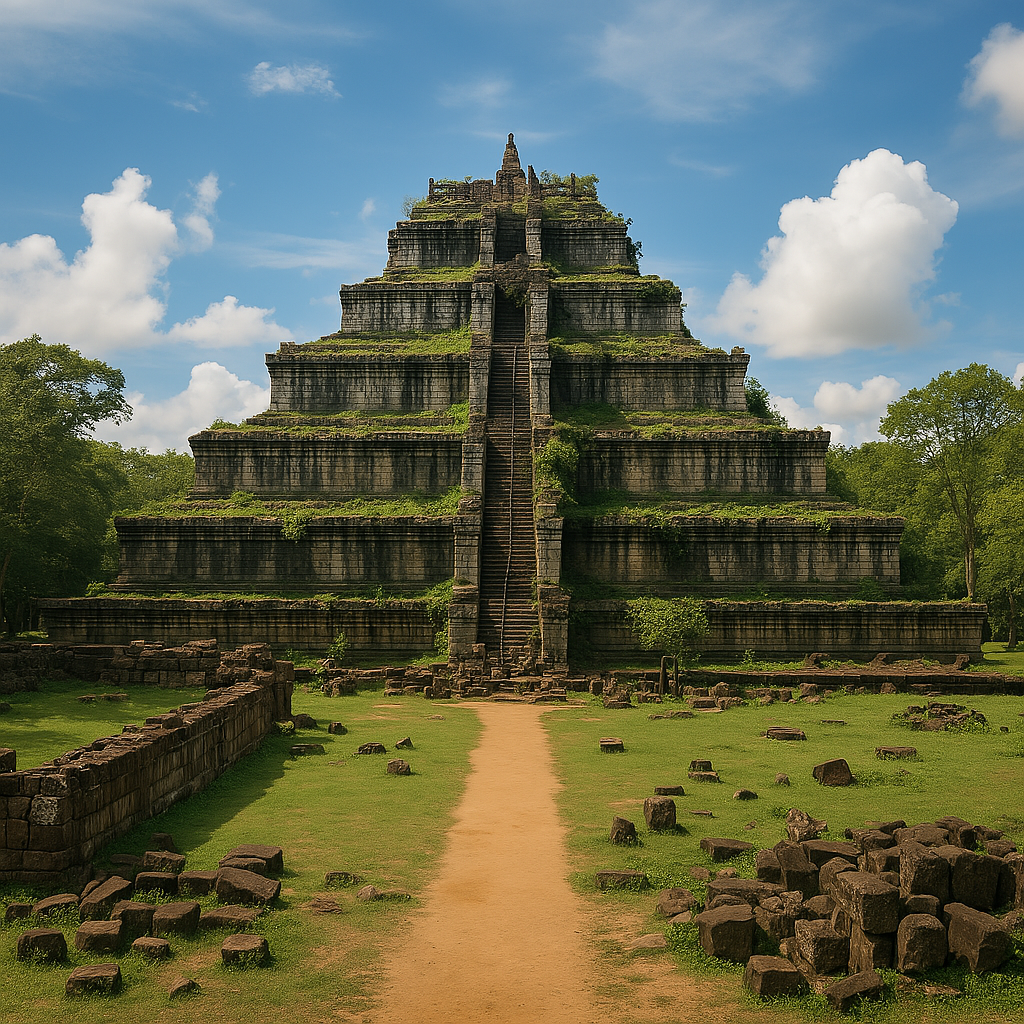Perched dramatically atop a 525-meter cliff in the Dângrêk Mountains, Prasat Preah Vihear (ប្រាសាទព្រះវិហារ – Temple of the Sacred Sanctuary) is one of Cambodia’s most breathtaking and historically significant temple sites. Located on the border with Thailand, this ancient Khmer sanctuary dedicated primarily to the Hindu god Shiva boasts a unique architectural layout perfectly adapted to its stunning natural setting. Recognized as a UNESCO World Heritage site, Preah Vihear is not only a masterpiece of Khmer artistry but also a potent symbol of Cambodian national identity, despite its geopolitically sensitive location.
Ancient Origins and Royal Patronage

While construction may have begun as early as the 9th century, Preah Vihear saw its main development during the height of the Khmer Empire, particularly during the 11th and first half of the 12th centuries under powerful kings such as Suryavarman I and Suryavarman II (the builder of Angkor Wat). Dedicated to Shiva, often worshipped in the form of a sacred linga housed in the main sanctuary, the temple served as an important royal chapel and a major pilgrimage destination for centuries, spiritually connected to the imperial capital at Angkor.
A Site of Outstanding Universal Value: UNESCO Status

In July 2008, Prasat Preah Vihear was inscribed on UNESCO’s World Heritage List. Its designation recognizes several key attributes:
- Architectural Adaptation: It is hailed as an outstanding masterpiece of Khmer architecture, uniquely adapted to its dramatic clifftop environment.
- Artistic Quality: The temple complex features exceptionally well-preserved and high-quality carved stone ornamentation, particularly on its lintels and pediments, representing various Angkorian art styles.
- Cultural Significance: It reflects the Hindu cosmology and civilization of the Khmer Empire. The inscription process itself was politically charged due to the ongoing border dispute with Thailand.
Contested Ground: Border Location and Disputes

Preah Vihear’s location is inherently sensitive, situated directly on the escarpment that forms the natural border between Cambodia’s Preah Vihear province and Thailand’s Sisaket province.
- ICJ Ruling: In 1962, the International Court of Justice (ICJ) in The Hague ruled that the temple itself is located in territory under the sovereignty of Cambodia.
- Ongoing Disputes: Despite the ruling on the temple structure, disagreements over the precise demarcation of the border line and sovereignty over adjacent lands have persisted. These disputes led to serious tensions and armed clashes between Cambodia and Thailand, most notably around 2008-2011, following the temple’s UNESCO inscription.
- Visitor Awareness: While the situation has been generally stable for some years, visitors should be aware of the historical context and rely on current official travel advisories. The presence of military personnel at the site is related to this border sensitivity.
Linear Masterpiece: Architectural Uniqueness

Unlike the concentric “temple-mountain” design typical of major Angkorian sites like Angkor Wat, Preah Vihear features a remarkable linear layout. Stretching approximately 800 meters along a North-South axis aligned with the cliff edge, the complex consists of:
- A Series of Gopuras: Visitors ascend through a succession of impressive gateways (gopuras) and courtyards, connected by causeways and staircases.
- Climax at the Cliff Edge: The path culminates at the main sanctuary (prasat), perched dramatically at the southern edge of the promontory, offering breathtaking panoramic views over the vast Cambodian plains below.
- Integration with Nature: The architecture masterfully utilizes the natural topography, creating a unique and awe-inspiring pilgrimage path integrated with the landscape.
- Artistic Styles: The temple showcases high-quality sandstone carvings, particularly lintels and pediments, reflecting influences from different periods, including the styles associated with Koh Ker and Baphuon.
Sacred Summit: Religious Significance

Preah Vihear was conceived and functioned for centuries primarily as a Hindu sanctuary dedicated to Shiva, the Destroyer and Regenerator, one of the principal deities of the Hindu pantheon. It likely housed important lingas representing the god’s divine energy. Its remote yet commanding location made it a powerful pilgrimage site. Like many other ancient Khmer temples, it was later adapted for Buddhist use as Theravada Buddhism became the dominant faith in Cambodia. Today, it remains a spiritually significant site for Cambodians, embodying both its Hindu origins and its continued reverence within a Buddhist cultural context.
Visiting Preah Vihear (As of April 2025)

Planning a visit requires some consideration:
- Access: The standard and recommended way to visit Preah Vihear is from the Cambodian side, via Preah Vihear province. Road conditions have improved significantly, but it remains a relatively remote destination requiring a journey of several hours by car or van from major hubs like Siem Reap (approx. 3-4 hours) or Phnom Penh (longer). Access from the Thai side via Khao Phra Wihan National Park has often been closed or restricted due to border issues and should not be assumed possible without checking the very latest official information.
- The Experience: A visit involves ascending the cliff path, passing through the various impressive gopuras and courtyards. Highlights include inspecting the well-preserved carvings, appreciating the unique linear architectural plan, and soaking in the absolutely stunning, expansive views from the cliff edge near the main sanctuary.
- Practicalities: It is wise to check the current security situation and any travel advisories before setting out, although the site is generally considered safe for tourists accessing via Cambodia during stable periods. Verify current opening hours and entrance fees. Dress respectfully (shoulders and knees covered). Bring ample water, sun protection, and wear comfortable walking shoes. Cambodian police and military personnel maintain a presence at the site due to its border location; this is normal. The journey through rural northern Cambodia is also part of the experience.
Conclusion
Prasat Preah Vihear is an extraordinary monument – architecturally unique, historically profound, and scenically spectacular. Its masterful adaptation to the dramatic clifftop setting and its exquisite carvings testify to the genius of Khmer civilization. While its location has been a source of international dispute, its status as a Cambodian national treasure and a UNESCO World Heritage site recognizing its outstanding universal value is affirmed. A visit to Preah Vihear offers not only a deep insight into Cambodia’s Angkorian past and religious history but also an unforgettable experience of natural beauty and architectural grandeur, deeply meaningful to Cambodians throughout the nation, including those in provinces like Battambang.





